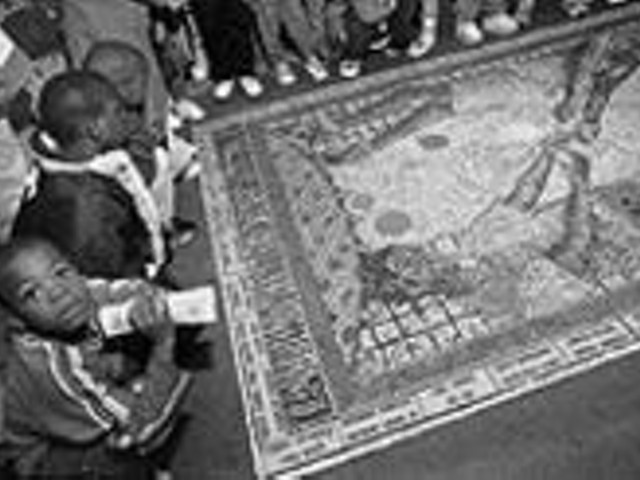Thus Mid America Dance Company's irrepressible and entertaining Cinderella: The Untold Story slides neatly into a burgeoning tradition. Choreographed by Todd Weeks, this "dance extravaganza" suggests that Cinderella actually was a scheming and selfish manipulator who had the Wicked Stepmother's support for her princely quest -- which leaves us one heroine short. Then again, perhaps there's a net gain in heroines: Madco's Cinderella casts the Wicked Stepsisters as earnest naïfs who want nothing more than a loopy pas de trois with this Prince Charming. This is where the production goes from inventive to deeply amusing -- the prince has evidently fallen in love with both of them. But true love is not destined to triumph in this engaging corrective to seasonal hysteria.
Here, Cinderella is not a drab urchin, and neither she nor Stepmother has much time for stepsisters Pruenella and Esmerelda. In fact, Cinderella is downright malicious when she shows the girls the wrong steps at Suzy Q's Dance Studio, earning them the wrath of the Ballet Mistress. And when just two invitations to the prince's ball are available, Cindy and Stepmum steal them from the sisters -- over the objections of the Prince himself. Fortunately, a convenient Fairy Godmother is lurking in a closet, and Pruenella and Esmerelda get spiffed up -- even if they do have to travel to the f ê te in a handcart instead of a pumpkin (FG's wand malfunctions). At the ball, the events follow the predictable course -- the Prince is smitten with the "mysterious beauties," who must flee at the stroke of midnight. Of course, we know a shoe is left behind, but exactly whose is the question.
Madco's Cinderella features much classical ballet (including a scene designed around barre and floor exercises), flavored with folk- and modern-dance styling. This melange is exciting, especially because choreographer Weeks favors an athletic approach and dancers are more likely to be in constant motion than striking poses and waiting for the next step. Company artistic director Stacy West has the distanced beauty of Mary Pickford (the long, blond, curly wig helps), and as Cinderella her fluid and economical technique juxtaposes provocatively with her character, who's required to sulk, pout, ball her fists and generally show perturbation. As the frosty stepmother, Kate Benkert Meacham is a willowy, regal dancer draped in flowing black. She isn't allowed much expression with her limbs -- her job is to chase the stepsisters and protect Cinderella, but in the ballroom scene she had an astonishing solo moment trying to distract the Prince. Leaping behind him, arms thrust skyward, Meacham was energized -- comic and threatening. Joey Hamrick (the Prince) has a sinewy muscularity that got him splendid height on his leaps and tight turns (usually initiated by others -- this dancer got to be a veritable wishbone in this love pentagon).
And the supporting players have marvelously expressive bodies and faces -- Tiffany Cunningham's Ballet Mistress had dignity and crack timing. John Vullo, in an electrified-Einstein wig and gold lamé sheath, imbued the Fairy Godmother with a Three Stooges manicness. And how many ballets feature a slapfest as part of the choreography? The corps dancers all brought great gusto to their various roles, and each had a moment to show off a leap or a pirouette.
But the unquestioned standouts were choreographer Weeks (Pruenella) and Gavin Sisson (Esmerelda). Having two male dancers in female roles (and Sisson is impressively tall) and garbing them in neon-colored frocks raises the theatrical ante -- is this going to be a joke? Or just kind-of-a-drag? Happily, Week and Sisson combine dancing skill with theatrical talent -- their stepsisters were certainly comic but also tragic. Much of their interaction was with one another, and given how different their bodies are (Weeks is compact, Sisson rangy), in their moves they presented harmony. And when frustrated (a frequent occurrence in this plot), both dancers managed sorrowful looks and body language that enlisted the sympathies of the audience. Pruenella and Esmerelda exemplified romantic angst better than any mere fairytale could have imagined.





